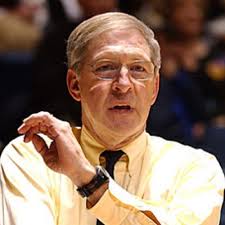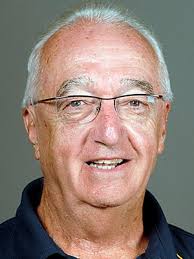It is easy to become the #1-ranked team in the nation: it is much harder to stay there, although Mark Few might beg to differ this year. Back in 1983, Coach Jerry Tarkanian brought his top-ranked UNLV team to West Virginia…and left with his worst loss of the season (87-78). His opposing coach that night was Gale Catlett, who was certainly no stranger to success: he won 3 straight SoCon titles as a player for the Mountaineers, made the 1966 Sweet 16 as an assistant to Lefty Driesell at Davidson, made the 1971 Final 4 as an assistant to Ted Owens at Kansas, made the 1972 Elite 8 as an assistant to Adolph Rupp at Kentucky, then won more the 550 combined games as a head coach at Cincinnati/West Virginia before retiring in 2002. HoopsHD’s Jon Teitel got to chat with West Virginia radio color analyst Jay Jacobs about Coach Catlett’s life and legacy. Today marks the 38th anniversary of that legendary upset of the Runnin’ Rebels on February 27, 1983.
In the 1963 NCAA tourney as a player at West Virginia, Gale’s teammate/All-American Rod Thorn scored a career-high 44 PTS in a 9-PT loss to St. Joe’s: was it just 1 of those scenarios where every shot he put up seemed to go in because he was “in the zone”? Rod was a different kind of player. Screening was very important: back then there was not as much 1-on-1 basketball. He had a 2-handed shot, which was very effective: during NCAA tourney play opponents would double-team him but he was so good that it did not matter.
In 1972 he was an assistant under Adolph Rupp for his final year at Kentucky: how did Gale get along with Rupp, and what made him such a great coach? He loved Coach Rupp. His foundation started even earlier. Coach Lefty Driesell brought him along at Davidson, and he also had a great relationship with Ted Owens at Kansas. Rupp had the ability to get things done in the right way. Gale had a great foundation and a great upbringing: after college he worked with Chuck Noe in Richmond.
Take me through the 1981 NIT as coach at his alma mater:
Dennis Hosey only scored 3 PTS but made a pair of FT with 5 seconds left in a 1-PT OT win at home over Temple: how was a 63% career FT shooter able to save the day with the game on the line? 1 of Gale’s great attributes was his ability to substitute the right people at the right time. He was ahead of his time in terms of being a late-game tactician so he had a great knack for what he needed to do. His practices were hard but the players respected him.
Diego McCoy scored a career-high 30 PTS but Greg Jones missed a 20-foot jumper at the buzzer in a 2-PT loss to eventual champion Tulsa: did you think the shot was going in? Greg had a good look: Diego was a good player but Greg was the foundation of the team so Gale put a lot of responsibility on him. It looked good to me but it hit the rim and bounced off.
In February 1983 Jones scored 32 PTS in a 9-PT nationally-televised upset of #1 UNLV, the school’s 1st win over a top-ranked team since 1966: where do you think that ranks among the biggest wins in school history, and what was the reaction like on campus? It was a tremendous victory for the school and the campus went crazy! Jones had a knack for playing to the crowd. He could take the ball baseline to baseline faster than anyone I ever saw. He was listed as a PG but seemed like a combo guard to me. Lester Rose was terrific on the inside and made some great plays: when UNLV saw that atmosphere they knew that it would be a tough day.
In the 1984 NCAA tourney JJ Crawl scored 4 PTS including a steal/lay-up in the final seconds of a 2-PT win over Oregon State (https://wvusports.com/news/2003/7/9/4937_131441744446677404.aspx): how did he prepare his team during the timeout before the game-winning play? They worked a lot during practice so he probably knew that JJ had quick hands and would square up on defense. The steal was so clean, just like Mike Gansey against UCLA (www.youtube.com/watch?v=ed_iLIhXPrQ).
In the 1987 NCAA tourney Kannard Johnson scored 15 PTS and made a layup off of an inbounds pass with 1 second left in a 2-PT win by Western Kentucky: where does that rank among the most devastating losses of his career? Everything hurt when he lost but he realized that the sun would shine the next day. When you have a career that long I would not rate it any higher than the others: all losses are bad.
In the 1989 NCAA tourney freshman Christian Laettner scored 14 PTS before fouling out in a 7-PT win by Duke: could you have imagined at the time that Laettner would eventually become the all-time leading scorer in NCAA tourney history? No, but he was a great shooter who could score from all angles. He could score inside or take you out to the perimeter so he was hard to guard. There have been very few games we have played against Duke: they are still the same team you want to beat today, just like you did back in 1989.
Take me through the 1998 NCAA tourney:
Jarrod West scored 15 PTS and banked in a 25-foot 3-PT shot with 0.8 seconds left in a 1-PT upset over #2-seed Cincinnati (www.youtube.com/watch?v=28ciC5ahPWI): where does that rank among the most amazing shots that you have ever seen? I am a very close friend of Bob Huggins. Gale and I have a fun argument about whether Kenyon Martin tipped the ball as it left West’s hand. Someone charged off our bench after it went in and Hugs says to this day that there should have been a technical foul!
Michael Doleac scored 25 PTS and made 2 FT with 7 seconds left to clinch a 3-PT win by eventual national runner-up Utah in Anaheim: how much of a factor is cross-country travel when it comes to success in March? I think it is a factor but in some ways it has been good for the Mountaineers. 24 hours after you play you are on a charter flight back east, but after going to the hotel in Boise and having some consultation the decision was made to stay out on the road and go directly to Anaheim. Huggins likes to take his team out early for bonding purposes whether it be in Cancun/Germany/Las Vegas. Gale had a good team with skill players at all positions. The funny part is that nobody had any clean clothes left: someone agreed to clean our clothes by the next day but it took 2 days. We had a large traveling party so the cleaning bill was $5000!
After retiring in 2002 he considered challenging incumbent Senator Robert Byrd in the 2006 Republican primary: how close did he come to running for office, and what has he been up to since then? I do not think he was that close to running. They wanted him to go into his hometown of Berkeley County to start out and he did not want to do that. It was not as serious as people made it. He is financially solid with a home in Morgantown, a chalet in Hedgesville, and a daughter who travels all over the world with the diplomatic corps. His 2nd daughter lives in Morgantown and has a couple of kids. The last time I saw him he was in real good shape and knows what is going on but he does not attend our games at the Coliseum. Once he retired he spent some time in Hawaii/Australia and would travel around the world.
When people look back on his career, how do you think that he should be remembered the most? In the 1980s he was terrific and was in postseason play very often. He slowed down around 2000 after the recruiting went down and he became disenchanted because he was a winner. I think that he will go down as 1 of the great coaches in school history. You cannot take away all of his wins and the way he coached a team: he was 1 of the best bench coaches I have ever seen. West Virginia has been blessed with coaches and he was a good friend.




